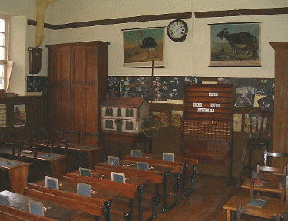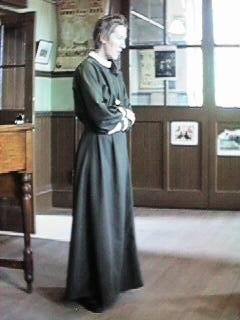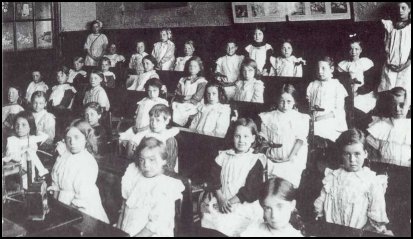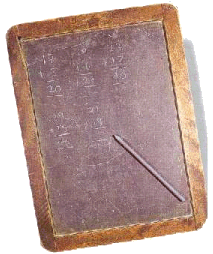
 Victorian
Schools
Victorian
Schools
Schools
There were several kinds
of school for poorer children. The youngest might go to a "Dame" school,run
by a local woman in a room of her house. The older ones went to a day school.
Other schools were organised by churches and charities. Among these were
the "ragged" schools which were for orphans and very poor children.
 School
room The school could be quite a grim building.
The rooms were warmed by a single stove or open fire. The walls of a Victorian
schoolroom were quite bare, except perhaps for an embroidered text. Curtains
were used to divide the schoolhouse into classrooms. The shouts of several
classes competed as they were taught side by side. There was little fresh
air because the windows were built high in the walls, to stop pupils
looking outside and being distracted from their work. Many schools were
built in the Victorian era, between 1837 and 1901. In the country you would
see barns being converted into schoolrooms. Increasing numbers of children
began to attend, and they became more and more crowded. But because school
managers didn’t like to spend money on repairs, buildings were allowed
to rot and broken equipment was not replaced.
School
room The school could be quite a grim building.
The rooms were warmed by a single stove or open fire. The walls of a Victorian
schoolroom were quite bare, except perhaps for an embroidered text. Curtains
were used to divide the schoolhouse into classrooms. The shouts of several
classes competed as they were taught side by side. There was little fresh
air because the windows were built high in the walls, to stop pupils
looking outside and being distracted from their work. Many schools were
built in the Victorian era, between 1837 and 1901. In the country you would
see barns being converted into schoolrooms. Increasing numbers of children
began to attend, and they became more and more crowded. But because school
managers didn’t like to spend money on repairs, buildings were allowed
to rot and broken equipment was not replaced.

Teachers
Children were often scared
of their teachers because they were very strict. Children as young as thirteen
helped the teacher to control the class. These “pupil teachers” scribbled
notes for their lessons in books .They received certificates which helped
them qualify as teachers when they were older. In schools before 1850 you
might see a single teacher instructing a class of over 100 children with
help of pupils called “monitors”. The head teacher quickly taught these
monitors, some of them as young as nine, who then tried to teach their
schoolmates. Salaries were low, and there were more women teaching
than men. The pale, lined faces of older teachers told a story. Some taught
only because they were too ill to do other jobs. The poor conditions in
schools simply made their health even worse. Sometimes, teachers were attacked
by angry parents. They shouted that their children should be at work earning
money, not wasting time at school. Teachers in rough areas had to learn
to box!
Pupils
 After
1870, all children from five to thirteen had to attend school by law. In
winter in the countryside, many children faced a teeth chattering walk
to school of several miles. A large number didn’t turn up. Lessons lasted
from 9am to 5pm, with a two hour lunch break. Because classes were so large,
pupils all had to do the same thing at the same time. The teacher barked
a command, and the children all opened their books. At the
second command they began copying sentences from the blackboard. When pupils
found their work boring, teachers found their pupils difficult to control.
After
1870, all children from five to thirteen had to attend school by law. In
winter in the countryside, many children faced a teeth chattering walk
to school of several miles. A large number didn’t turn up. Lessons lasted
from 9am to 5pm, with a two hour lunch break. Because classes were so large,
pupils all had to do the same thing at the same time. The teacher barked
a command, and the children all opened their books. At the
second command they began copying sentences from the blackboard. When pupils
found their work boring, teachers found their pupils difficult to control.
Lessons
Victorian lessons concentrated
on the “three Rs”-Reading, wRiting and aRithmetic. Children learnt by reciting
things like parrots, until they were word perfect. It was not an exciting
form of learning! Science was taught by “object lesson”. Snails, models
of trees, sunflowers , stuffed dogs, crystals, wheat or pictures of elephants
and camels were placed on each pupil’s desk as the subject for the lesson.
The object lesson was supposed to make children observe, then talk about
what they had seen. Unfortunately, many teachers found it easier to chalk
up lists describing the object, for the class to copy. Geography meant
yet more copying and reciting - listing the countries on a globe, or chanting
the names of railway stations between London and Holyhead. If you
look at a timetable from late in the 1800s and you will see a greater number
of subjects, including needlework, cookery and woodwork. But the teacher
still taught them by chalking and talking.
 Slates
and copybooks
Slates
and copybooks
Children learned to write
on slates, they scratched letters on them with sharpened pieces of slate.
Paper was expensive, but slates could be used again and again. Children
were supposed to bring sponges to clean them. Most just spat on the slates,
and rubbed them clean with their sleeves. Older children learned to use
pen and ink by writing in “copybooks”. Each morning the ink monitor filled
up little, clay ink wells and handed them round from a tray. Pens were
fitted with scratchy, leaking nibs, and children were punished for spilling
ink which “blotted their copybooks”. Teaches also gave dictation, reading
out strange poems which the children had to spell out correctly.
Reader
Slates showing pictures
and names of different objects hang from the walls of the infants class.
The children chant the name of each object in turn. When they can use these
words in sentences they will move on to a “reader”. This would p probably
be the Bible. For reading lessons, the pupils lined up with their toes
touching a semi-circle chalked on the floor. They took it in turns to read
aloud from the bible. The words didn’t sound like everyday words, children
stumbled over the long sentences. Quicker readers fidgeted as they waited
for their turn to read. School inspectors slowly realised that the bibles
language was too difficult. Bibles were gradually replaced by books of
moral stories, with titles like Harriet and the Matches. A reader had to
last for a whole year. If the class read it too quickly, they had to go
back to the beginning and read it all over again!
Abacus
The pupils used an abacus
to help them with their maths. Calculations were made using imperial weights
and measures instead of our simpler metric system. Children had to pass
inspections in maths, reading and writing before they could move up to
the next class or “standard”. Teachers were also tested by the dreaded
inspector, to make sure that they deserved government funds.
Cane
Teachers handed out regular
canings. Look inside the “punishment book” that every school kept, and
you will see many reasons for these beatings: rude conduct, leaving the
playground without permission, sulkiness, answering back, missing Sunday
prayers, throwing ink pellets and being late. Boys were caned across their
bottoms, and girls across their hands or bare legs. Some teachers broke
canes with their fury, and kept birch rods in jars of water to make them
more supple. Victims had to chose which cane they wished to be beaten with!
 Dunce's
Cap
Dunce's
Cap
Punishment did not end
with caning. Students had to stand on a stool at the back of the class,
wearing an arm band with DUNCE written on it. The teacher then took a tall,
cone-shaped hat decorated with a large “D”, and placed it on the boys head.
Today we know that some children learn more slowly than others. Victorian
teachers believed that all children could learn at the same speed, and
if some fell behind then they should be punished for not trying hard enough.
Drill
When its time for PE
or “drill”, a pupil teacher starts playing an out-of-tune piano . The children
jog, stretch and lift weights in time to the awful music. It is like
a Victorian aerobics class! Even when the teacher rings a heavy , brass
bell to announce the end of school, the pupils march out to the playground
in perfect time
Playtime
Outside the classroom
is a small yard crowded with shrieking schoolmates. Games of blind mans
buff, snakes and ladders, hide-and-seek and hopscotch are in full swing.
Some boys would beg a pigs bladder from the butcher, which they would blow
up to use as a football. Others drilled hob nails through cotton reels
to make spinning tops.